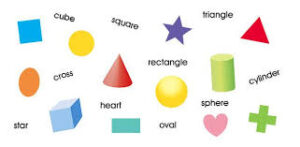During this week’s class, we went over chapters 5 & 6 from the Making Classroom Assessment Work textbook by Anne Davies. In these two chapters, some highlighted topics were about evidence, observation, triangulation, self-assessment, and feedback. My symbol for this week’s summary blog to represent the class is shapes- more specifically a triangle. I learned about a new strategy of Triangulation which is when evidence collected from 3 different sources over time, trends and patterns becoming apparent, and reliability validity of our classroom assessment is increased (Davies, 2020, p.47). We also dove into an example where we wrote a rubric of assessment for math students in grade five when they look at a square and rectangle with square grids inside.
Creating the rubric took about an hour and a half (roughly) where my group was given the task to try and create a rubric of assessment from the perspective of a student in the fifth Grade, then we elevated it based off of the curriculum, to then compare it to the the rubrics of the true assessment piece set for that assignment/outcome. This gave me a different outlook and perspective on how to assess students and applying different expectations on students- this also gave me intel on grade curriculums for those in grade 5, which was extremely new to me as I am in University for early elementary and I have no experience working with students of those ages.
The chapters this week were on the shorter side, however, they had the same amount of importance and intel. I would say that this section of chapters was one of my favourites, however, I am learning a plethora of new knowledge/ strategies/ and ideas from the textbook thus far.
During the learning circle, I was the recorder! Having this role this week, I found that I became even more attentive to my peers and was calculating my own thoughts more so before speaking them. This gave me another perspective on myself where I should be always acting and performing as if my thoughts and voice can be rewinded and played back to me.
The dialogue facilitator left plenty of space for us to build off of their questions, instead of a simple yes or no. We dove deeper into the concepts of observation and how we personally feel about the process of it and Triangulation. We also talked about how we felt and children/ students when we knew we were being observed and our assignments were products and not conversation. We also touched back on a phrase I mentioned in my previous summary of “keeping the end in mind” (Davies, 2020, p.25). We are starting to piece together how all of these seemingly small aspects that go into assessment and evaluation all play their own big and important role in the process of learning, observing, and assessing.
Another topic that played a large role in our learning circle was that of self-assessment and its process. We discussed how it is extremely important to have students involved in classroom assessment and their assessment for learning. We discussed that all children/students have important input on the goals, criteria, quality, and details being imparted to them, and how in order to give themselves feedback, we have to provide guidelines and structure while having them be part of their own teaching/ learning process.
Overall, this week’s class and learning circle gave a different outlook on what we have been covering and learning in this class. There are multiple shapes that learning can take depending on the steps we take as educators, and how we involve the students in their own learning.
Davies, A. (2020). Making Classroom Assessment Work (4th ed.). connect2learning.

